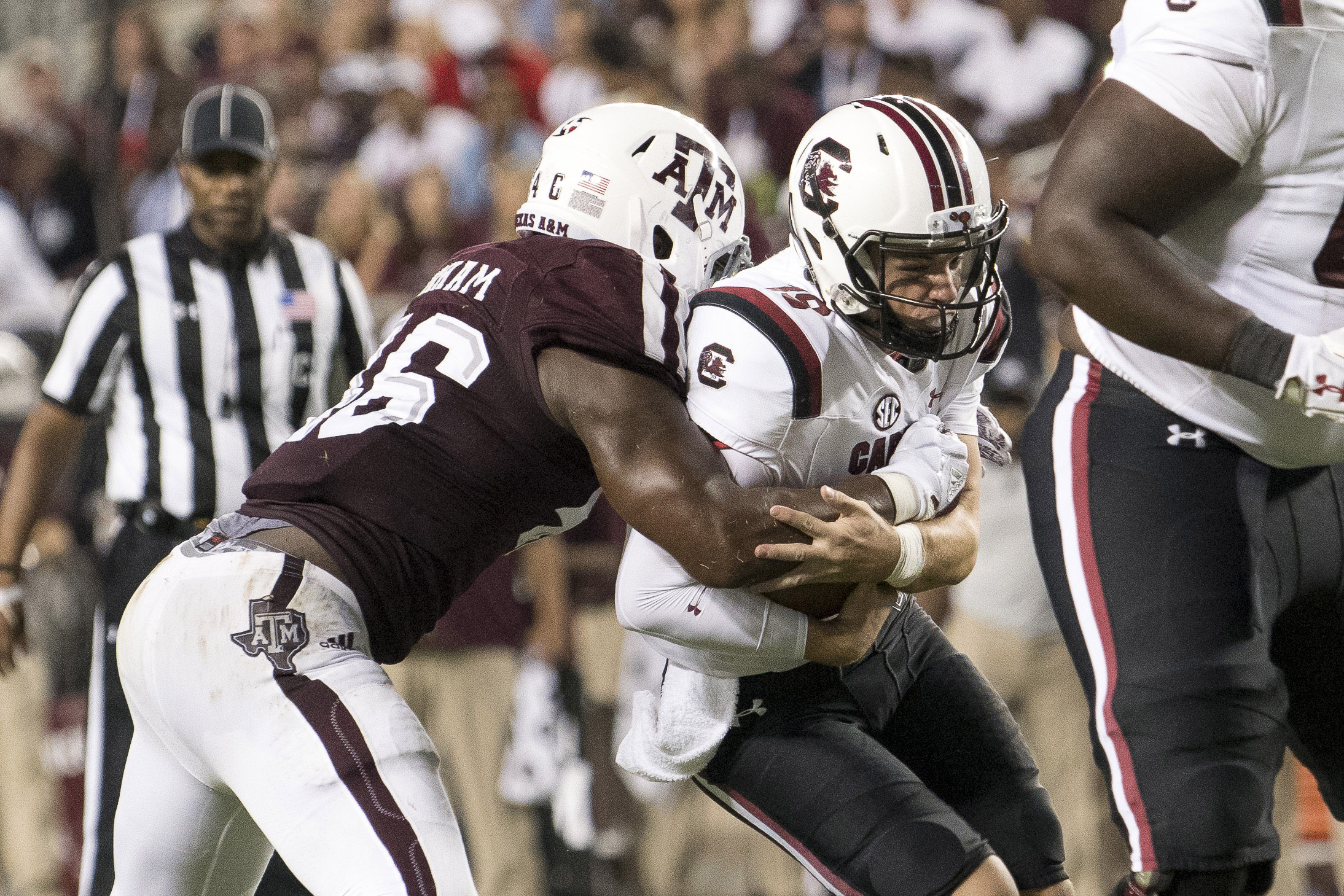
Film Study: How Texas A&M’s revamped pass rush has turned up the heat on opposing QBs. Is Jalen Hurts next?
By Matt Hinton
Published:
Generally speaking, when a team loses a pair of next-level pass rushers on the order of Myles Garrett and Daeshon Hall — first- and third-round picks, respectively, with 67 career sacks between them — at the same time, the results on the field are not supposed to improve. Alabama can absorb that kind of attrition, maybe LSU; not many others. Nearly halfway through the regular season, though, Texas A&M is right on schedule to do just that.
It’s ahead of schedule, actually: In their past two games, the Aggies have racked up 13 sacks against Arkansas and South Carolina, the best two-game stretch of the Kevin Sumlin era, bringing their total to 20 sacks for the year — most in the SEC through five weeks, and just one off the national lead. (In terms of negative yardage on sacks A&M’s defense ranks No. 1.) That’s one full sack per game better than the 2016 pace set by Garrett and Hall. And on top of the official takedowns, A&M also generated a dozen QB hurries and/or hits against the Razorbacks and Gamecocks, making the pass rush arguably the most crucial aspect of its 2-0 start in conference play.
At one point last week, in the fourth quarter of their come-from-behind victory over Carolina, the Aggies sacked Gamecocks QB Jake Bentley five times in nine plays. The result: Three consecutive three-and-outs, the first two of which set up the tying and go-ahead touchdown drives by the offense near midfield.
Just as importantly, those five sacks were credited to four players, reinforcing the fact that this year’s unit has many more options at its disposal than a pair of speed merchants beating offensive tackles around the corner — it’s already proven it can get to the quarterback with power as well as speed, from the interior and off the edge, or via an assortment of blitzes. Today, ahead of this weekend’s season-defining date with Bama, we’ll focus on a blitz that defensive coordinator John Chavis has returned to repeatedly on obvious passing downs, and which has been consistently productive in getting opposing offenses off the field.
Brother Can You Spare a Blitz. Counterintuitively, many of Chavis’ successful pressure looks involve dime personnel — i.e. six defensive backs, leaving just five men (typically three down linemen and two linebackers) in the box. A 3-2-6 alignment isn’t very well-suited to be an every-down defense, for obvious reasons. For a blitz-happy coordinator like Chavis, though, when the down and distance dictates pass, the dime look gives him more options for spreading opposing blocking schemes thin without sacrificing coverage.
We’ll start with a play from South Carolina’s final possession last weekend, mainly because it was one of the few on which ESPN’s broadcast was generous enough to provide an end zone angle of the blocking. But it was also typical of the way Chavis has attacked in similar situations. In this case, the Gamecocks faced 2nd-and-12 with a little over a minute remaining, down 24-17 and needing a touchdown to tie the game. A&M lined up with a nose tackle (Kingsley Keke) directly over the center and two ends well outside of the offensive tackles’ outside shoulders, both in a four-point pass-rushing stance; in between, the Aggies deployed two linebackers — one (Tyrel Dodson) at normal depth, the other (Otaro Alaka) aligned head-up over the right guard as a stand-up blitzer.

Ideally, this scheme is designed to give Dodson a free run at the quarterback by inducing South Carolina’s RG (No. 72 Donell Stanley) to account for Alaka’s initial rush into the A gap, leaving the B gap unaccounted for while end Landis Durham occupies the right tackle. That didn’t happen here; both Stanley and the center (No. 70 Alan Knott) managed to recognize the blitz in time to pick up both blitzing ‘backers. Instead, the victim in this case was the left guard (No. 50 Sadarius Hutcherson, a redshirt freshman), who was beaten badly and immediately by Keke:
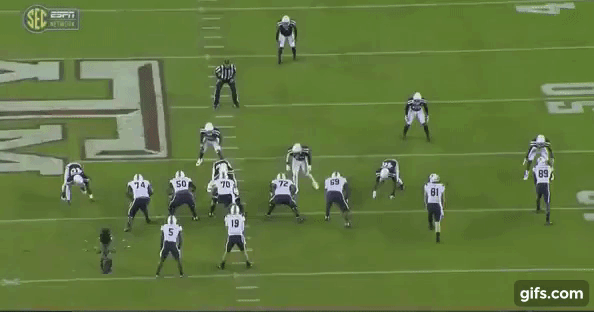
Although he didn’t come free on the blitz, Dodson still scored a direct hit on the quarterback as Bentley heaved the ball out of bounds — the futile result of a) one missed block and b) a well-executed scheme that cut off any viable avenue for escape once the pocket began to break down.
For an example of what the same design looks like when the blitz does come free, we’ll rewind to a bit earlier in the fourth quarter, with the game still tied and South Carolina facing 3rd-and-8 from its own 22-yard line. On A&M’s side, the only difference in this play and the one above is that the linebackers swapped assignments: This time it’s Dodson lined up over the right guard with Alaka (highlighted below) following on the blitz.
Unlike above, this time the RG took the bait, leaving the task of picking up Alaka to a running back who … well, honestly, who probably shouldn’t be assigned with picking up any more blitzes any time soon:
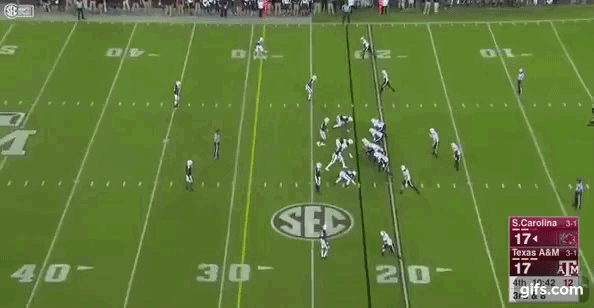
That was one of two second-half sacks for Alaka, who had the game of his life against Carolina with career-highs for total tackles (9) and tackles for loss (five, including the sacks). He’s one of four Aggies this week — along with Durham, Dodson and safety Armani Watts — who rank among the SEC’s top 10 for the year with at least five TFLs apiece.
Two weeks ago, Texas A&M got to Arkansas quarterback Austin Allen with a couple of variations on the same basic premise. First, we’ll look at a 3rd-and-8 attempt in the second quarter; in this case, Chavis deployed the same 3-2-6 personnel as on the plays we saw above, with the key difference that Dodson (No. 25 below) lined up as an outside rusher over the Razorbacks’ right tackle. Instead, the job of occupying the right guard (No. 68 Kirby Adcock, a true freshman) fell this time to the end, Landis Durham (46), whose inside rush effectively opened up a lane for backup linebacker Anthony Hines III (19) to flush Allen from the pocket:
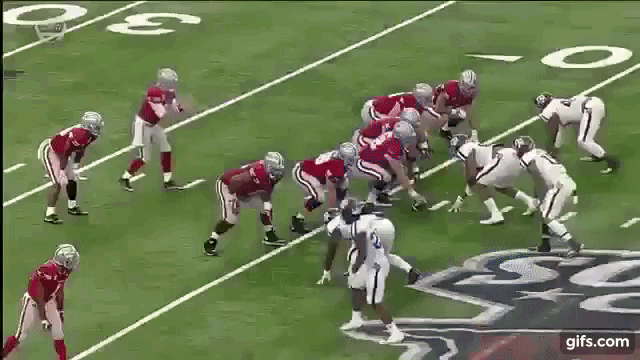
Durham, a junior, has emerged as surprise leader on the d-line — he was named SEC Defensive Player of the Week for his performance against South Carolina, barely a month after opening the season third on the depth chart — and here it’s easy to see why: On the same play, he was strong enough to toss the 288-pound Adcock aside like a rag doll and quick enough to chase Allen down for the sack after Hines forced the QB to tuck and run. Not that anyone’s about to mistake him for Myles Garrett, but Durham has shown a propensity for making plays that could put him in the running for an all-conference nod.
Later on Arkansas faced 3rd-and-14 from its own 26; again Chavis showed the Razorbacks a 3-2-6 look with both linebackers, Dodson and Alaka, at normal depth for a change. Just as we saw above, though, the concept hasn’t changed: Again, Alaka attacked the A gap to the center’s left (Keke occupied the right A gap), ostensibly to open up a path Dodson through the B gap while end Jarrett Johnson (40) applied pressure from the outside. The wrinkle was a nickel blitz to the opposite side of the formation by cornerback Priest Willis.
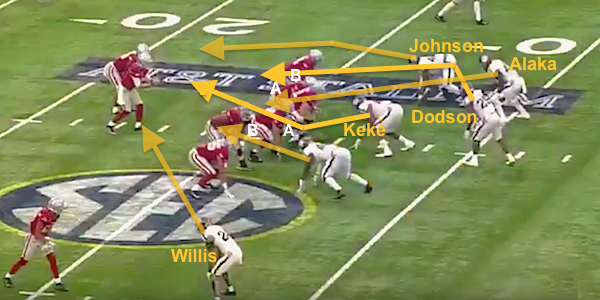
The play was a mess for the Razorbacks from the start, with Johnson blowing past the left tackle (No. 74 Colton Jackson) and Keke coming free up the middle after splitting the RG and center with a swim move. The running back on the play (mercifully, for Allen’s sake) prevented Willis from getting a free shot on the quarterback off the blitz, but not from cutting off any chance Allen might have to escape to his right, forcing a throw to nowhere and subsequent punt.
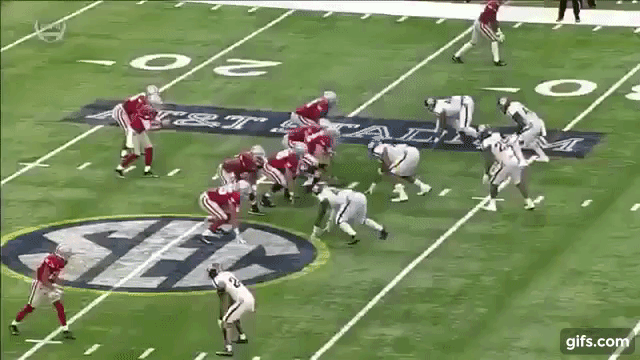
The design on that call was nearly identical to a blitz Chavis deployed in the season opener against UCLA, to exploit a certain passing situation on a 3rd-and-10 play late in the first half.
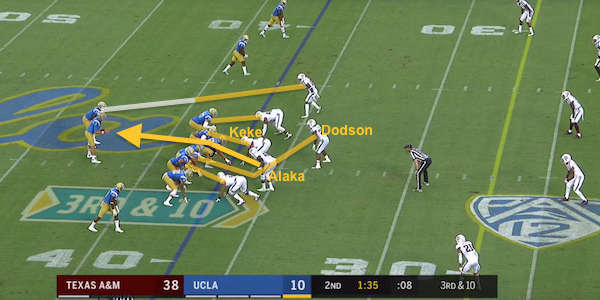
Again, Keke and Alaka, creeping head-up over the left guard, were responsible for attacking the A gaps; again, Dodson was the designated B-gap blitzer behind Alaka’s inside rush, with backside pressure from nickel corner Deshawn Capers-Smith. And again, the quarterback was forced to chuck a hopeless pass to no one in particular as a free rusher bore down — that would be Alaka this time, who forced his way past the Bruins’ All-Pac-12 center, Scott Quessenberry:
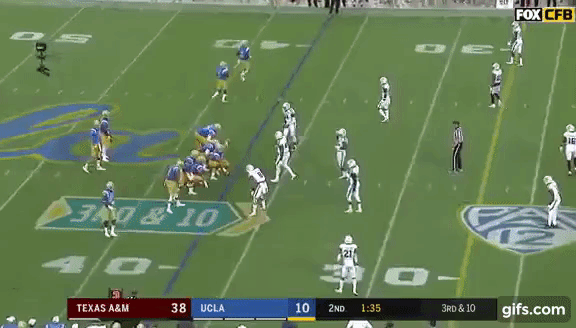
Ironically, after pummeling Rosen for most of the first three quarters the Aggies continued to blitz regularly in the fourth and paid dearly for it as the Bruins managed to adjust and find favorable matchups for tight end Caleb Wilson in the middle of the field en route to one of the most gobsmacking comebacks on record. (In fairness to A&M, it turns out that almost all matchups in the middle of the field are favorable for Wilson, the FBS leader in receptions among tight ends.)
But A&M’s not likely to face another quarterback this season on the level of Josh Rosen, and the sack parade of the past two weeks has only serve to entrench an aggressive, blitz-heavy style as part of the team’s identity. It’s one of the reasons they hired Chavis in the first place, and as long as they manage to keep opposing offenses in second- and third-and-long, he’s going to keep them coming out ahead.
To Saturday and Beyond. In some sense the Alabama game is “season-defining” for every team in the SEC West, but for A&M in particular it’s defined the moment everything starts to fall apart: Each of the past two years the Aggies have arrived at Bama week undefeated, ranked in the top 10, and in both seasons they’ve limped out toward losing records (3-4 in 2015, 2-4 last year) over the second half of the season. Before that, the 59-0 massacre in Tuscaloosa in 2014 was arguably the moment A&M ceased to be viewed as an up-and-coming program under Kevin Sumlin, and the attention shifted instead to how much longer he’d keep his job. Three years later, nothing has changed except the volume of the speculation.
Even if the Aggies have almost no chance of beating Bama — just 6.6 percent, according to ESPN’s Football Power Index — just keeping it competitive against an outfit that has continued to lay waste to the rest of the conference this year will be a positive step in the right direction. Even to get that far, the run defense will have to hold up its end of the bargain against the deepest, most productive ground game in the nation that’s not based on the triple option, just to give Chavis’ blitz packages a chance on obvious passing downs in the first place.
It’s been ages since an opposing defense could claim it shut down Alabama’s running game with a straight face. And while A&M is clearly improved against the run, statistically, it’s impossible to separate that from having yet faced a really competent running attack. (The sacks help in that regard, too, since officially negative yardage on sacks counts against opponents’ rushing totals.) Not including sacks, Arkansas ran for 265 yards on 6.8 per carry against the Aggies, its best outing of the young season.
That’s the challenge, because given half an opportunity it’s not had to imagine Chavis devising pressure schemes that force Jalen Hurts to operate well outside of his comfort zone as a passer. Lord knows the Crimson Tide are due for a couple turnovers.
The pass rush was the most surprising and productive aspect of the team over the first month of the season, and if the next two months are going to go down as a success — especially opposite a true freshman quarterback on offense — it will have to continue to do some heavy lifting. If not, with Florida, Mississippi State, and Auburn on deck, this is another campaign with the potential to spiral out of control in a hurry. For now, the Aggies’ ongoing ability to get after opposing quarterbacks is still the best chance they have of preventing that from happening.
Matt Hinton, author of 'Monday Down South' and our resident QB guru, has previously written for Dr. Saturday, CBS and Grantland.







